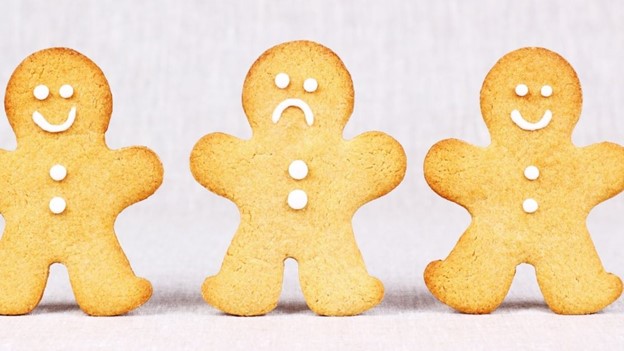
Today’s Morning Buzz is by Jackie Wehmeyer, Senior Director of Strategy and Intergovernmental Affairs for the City of Parkland, Florida. Parkland was named one of the Best Places to Work in Local Government in 2021 by ELGL and a Top Workplace in 2022. Connect with Jackie on LinkedIn.
What I’m cooking: Homemade pierogis with my kids this weekend
What I’m watching: Nearly endless loops of Christmas Vacation. It’s a tradition.
What I’m working on: A new public art program for our city
I told myself I should write a Morning Buzz that’s more tongue-in-cheek, playful, and fun this month. It’s the holidays, after all! But the holidays can make things challenging for everyone, let alone those who find this time of year somewhat tricky. The holiday season is revered as a time of joy, celebration, and togetherness. For many people, including the employees and coworkers we work with daily, the holidays can be a taxing time marked by feelings of sadness and loneliness. While the world around us is covered with festive decorations and cheerful music, some people find themselves managing feelings of melancholy that seem to intensify during this time of year.
I’ll admit that there are times during the holidays that I, too, feel sad. Some song will play in the background holiday music in a store that brings tears to my eyes, and I don’t immediately know why. Then I realize that this time of year reminds me of people I’ve lost in my life and times in my life that I may or may not want to revisit.
Why can’t we all fall in line with holiday happiness? There are several reasons the holiday blues seep in.
Holiday sadness can be complex
Holiday sadness is an intricate emotional experience that can be triggered by various factors. One common cause is the pressure to meet societal expectations of happiness during this season. The concentration on family gatherings, gift-giving, and festive cheer can emphasize feelings of isolation for those who cannot be with family or have strained relationships with their families.
Loss and grief can be magnified
For individuals who have experienced loss, the holidays can serve as heartbreaking reminders of the absence of loved ones. Whether it be the first holiday season without a family member or the anniversary of a significant loss, the festivities of the holidays can worsen feelings of grief, making it a tough time to navigate emotionally.
Health issues can make celebrations difficult
Besides the struggle of travel to be with loved ones, some people with health issues or chronic illnesses don’t feel physically or emotionally able to be with others during the holidays. The holidays can be exhausting, and restrictions may keep them from participating in festivities that can quickly tire them.
The holidays can be expensive
The financial strain associated with holiday expenses can also contribute to increased stress and sadness. The societal pressure to exchange lavish gifts and host elaborate celebrations can lead to financial strain, creating a sense of shortcoming and worry for those struggling financially.
Social media highlights the unrealistic
Social media can play a role in increasing holiday sadness by continuing a culture of comparison. People often portray their seemingly perfect holiday celebrations online, creating an unrealistic standard that can make those experiencing sadness feel even more isolated and inadequate.
So as leaders, how can we help our employees cope with stress and sadness at this time of year?
Promote Open Communication
Create an open and non-judgmental space for employees to share their feelings. Encourage managers and team leaders to regularly check in on their team members, showing genuine concern for their well-being. Knowing that their emotions are acknowledged and understood can be a significant relief for employees experiencing holiday sadness.
Flexible Work Arrangements
Recognize that the holiday season may come with additional personal responsibilities and emotional challenges. Offering flexible work arrangements, such as adjusted schedules, can help employees manage their stress and maintain a healthier work-life balance.
Employee Assistance Programs (EAPs)
Ensure that employees are aware of your organization’s Employee Assistance Program. EAPs provide confidential counseling services, mental health resources, and support for various personal challenges. Communicate the availability of these programs to employees as part of a broader effort to prioritize their well-being.
Holiday Celebrations
Give employees some grace and leeway when celebrating the holidays in the workplace. Provide a safe space for those not feeling like they want to participate, and let them know you respect their choice while caring for their perspective.
Provide Emotional Support
Training leaders to recognize signs of distress and respond with empathy is crucial. Ensure that supervisors are equipped to provide emotional support through active listening or guiding employees to appropriate resources. Promote a culture where employees feel comfortable discussing their feelings without fear of stigma.
Create a Positive Work Environment
Foster a positive and supportive work environment throughout the year. Encourage team-building activities, express appreciation for employees’ efforts, and cultivate a workplace culture that values both professional and personal well-being. A positive work environment contributes to a sense of belonging and can be a powerful way to ward off the holiday blues.
Supporting employees experiencing sadness during the holidays is a responsibility that we, as leaders, should take seriously. By prioritizing mental health, promoting open communication, and fostering a positive workplace culture, we can contribute to a healthier and more supportive environment for our team members during the holiday season and throughout the year.
